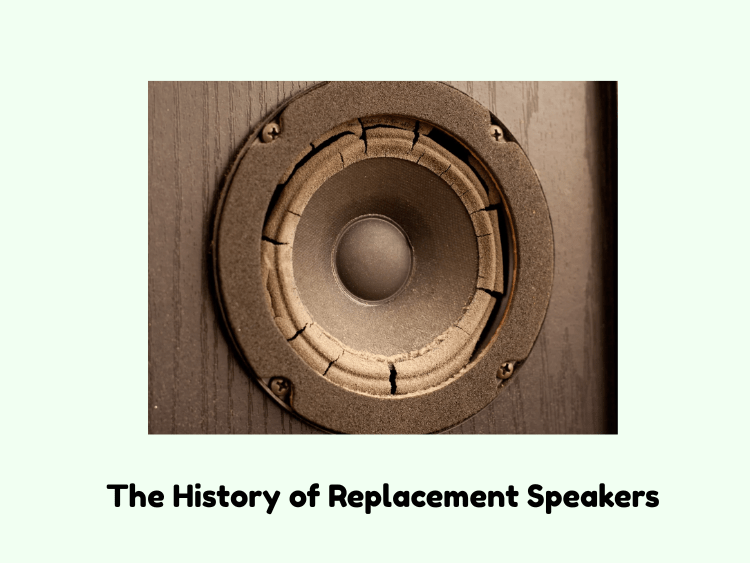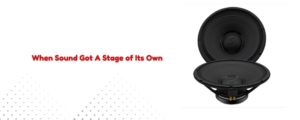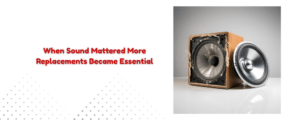Sound technology advancements have changed a lot over the years, and new speakers have changed along with it. Replacement speakers have been an important part of keeping sound systems in good shape, making them better, and making the listening experience more personal since the early days of simple sound systems. To understand the past of new speakers, you have to look at how loudspeakers, consumer gadgets, and music culture have changed over time.
How Loudspeakers Got Their Start
Before discussing new speakers, it’s important to know where the original speaker evolution came from. In the late 1800s, the first person thought of a way to turn electrical data into sound. In his work to build the telephone, Alexander Graham Bell made early versions of speakers that could turn electrical sound signals into music.
A very early form of the dynamic speaker was invented by the German creator Ernst Siemens in 1877. However, speakers didn’t become more common until the 1920s, when radio broadcasts became more popular. RCA (Radio Corporation of America) made the first amplifier that sold well in 1925. It changed the way people listened to music at home.
The Rise of Home Audio and the Start of Needs for Replacement
In the 1930s through the 1950s, radios, record players, and later TVs became common home items. This made it clear that speakers needed to be maintained and fixed. A lot of the first monitors were big and built into wooden boxes. If a speaker broke, it generally meant that the whole unit had to be fixed or replaced. This era marked a significant chapter in the history of speakers, as the demand for better sound systems and speaker maintenance began to grow alongside the popularity of home entertainment devices.
But by the middle of the 20th century, speaker designs were more like Lego blocks. Audio fans and experts began making speaker casings that made it easy to get to the different parts. This flexible method set the stage for the market for new speakers. For the first time, users could replace a broken driver without having to clean up the whole system.
The 1960s and 1970s Hi-Fi Boom
The “hi-fi” (high fidelity) boom in the 1960s and 1970s was a great time for music lovers. Sound reproduction got better thanks to brands like JBL, Klipsch, Bose, and Wharfedale. People started spending a lot of money on home music systems, which led to more modifications.
This is when the idea of changing speakers went from being a necessary evil to a fun hobby. Fans tried out different speakers to make their sound experience more personal. As people started to change their speakers, whether it was a woofer for more bass or a tweeter for clear highs, the replacement speaker business took off.
In response, manufacturers made new parts for their own systems and even general parts that could be used with a wide range of brands. There was a start to an industry for new speakers.
The New Era of Car Audio
In the 1980s and 1990s, the car audio scene grew quickly, just like home audio. Since factory-installed car speakers didn’t always sound great, more and more people were looking for aftermarket alternatives.
Pioneer, Alpine, Sony, and Kenwood were among the first companies to make high-performance substitute speakers that were made to fit cars. It became popular to use coaxial and component sound systems, and installation kits made it easy for regular people to make their own improvements.
Sound pressure level (SPL) events and other popular car audio challenges pushed speaker designers to come up with new ideas. For car fans, replacing original speakers with aftermarket ones became a rite of passage. This created a booming market for replacement speakers in the automobile sector. Those exploring such options can often find a range of solutions through specialized audio equipment suppliers like business5core.com.
There Are Portable Speakers and the Digital Age
The digital revolution in the 2000s caused a huge change. The way we listen to music has changed a lot thanks to MP3 players, smartphones, Bluetooth speakers, and home theater systems. The speaker’s business changed along with what people wanted.
There is also a market for replacement speakers in handheld music. Bluetooth speakers, soundbars, and wireless home helpers (like Amazon Echo and Google Nest) are often locked units, but tech-savvy people have found ways to improve them or repair broken parts. Online groups and YouTube videos have taught a whole new generation of people how to fix or improve their speakers on their own.
In professional audio and home theater, brands started selling high-end substitute parts like woofers, tweeters, middle drivers, and crossovers so that users could fix up their old systems instead of buying new ones.
The Growth of Online Markets and Easy Access Around the World
With the rise of online shopping sites like Amazon, eBay, and AliExpress, it’s now easier than ever to find new speakers. At different price points, customers could buy everything from name-brand cars to cheap knockoffs. Online groups like Reddit, AVS Forum, and DIYAudio also let people share information and help each other with problems, giving users even more power to fix and manage their audio equipment. This opening up of information and access to more people sparked a global market of substitute speakers. Audiophiles and people on a budget turned to brands like Dayton Audio, 5Core Replacement Speakers, Monoprice, and Parts Express as their go-to sites.
Durability and Changing the Speaker
Sustainability has become a very important issue in household technology in the last few years. People are told not to throw away whole audio systems but to fix and improve parts of them, especially the speakers. Brands have begun to follow this trend. Companies like KEF, 5Core, and Bowers & Wilkins offer official new drivers and parts because they know how important it is to keep products working longer. Also, the market for used and repaired speakers is growing. This focus on being able to fix things fits with larger environmental goals, and new speakers are a big part of the push in tech to make things more eco-friendly. This shift is also a natural part of speaker evolution, where sustainability and longevity are becoming just as important as performance and innovation.
What’s Next for Replacement Speakers
Looking ahead, the future of new speakers will be shaped by a number of trends:
- Separated sound systems: Some new speakers are made so that the internal parts are easy to get to, which makes replacing them easier.
- 3D printing: People who like to do things on their own use 3D printing to make unique speaker casings and parts to fix and replace speakers.
- Smart home integration: As smart home technology becomes more common, more and more people want to know how to fix and replace parts in products like the Amazon Echo and Google Nest.
- Sonic personalization: In the future, systems might let people change or swap speaker parts to get a more customized sound, using AI to do this.
Conclusion
The past of new speakers is an interesting look at how technology has changed and how people’s habits have changed over time. What started out as a way to keep old audio equipment in good shape has grown into a worldwide business that helps audiophiles, car fans, service workers, and regular people. As more people adopt digital conveniences and eco-friendly habits, new speakers are more important than ever. They are a useful way to protect favorite audio systems, improve performance, and cut down on electronic waste. This way, we can make sure that the music in our lives stays rich, engaging, and long-lasting—continuing the journey of speaker evolution through every generation.





